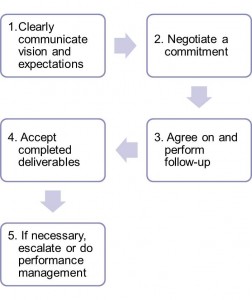Often leaders ask me how to improve accountability within their project-based organization. However, that leader may actually be contributing to the accountability problem without realizing it, often because he communicates his expectations poorly or not at all.
I believe that accountability starts with clear communication. You can’t hold someone accountable unless they first understand what you expect from them and why you think it is important. Therefore the first step is clearly communicating your vision and expectations.
Follow that by explicitly negotiating a commitment. Don’t expect the other person to read your mind or guess at what you want. There should be discussion and agreement at this point. You’re aiming to get the other person to buy in and take ownership. Otherwise, the best you will get is compliance instead of top performance. Often you won’t even get compliance.
The negotiated commitment should include agreement on what follow-up and check-ins will occur while the work is being done. Then both parties should make sure they carry out that follow-up. You may want to add some reminders to your calendar or action item list to help with this.
When the agreed upon work is done, clearly communicate whether it is satisfactory to you. If so, explicitly agree that the commitment has been fulfilled. If not, explain why and renegotiate the commitment. If you’ve been doing good follow-up during the work period, there will rarely be surprises at this stage. Remember to acknowledge and spotlight good performance.
If this process doesn’t work and you can’t come to an agreement, escalate (or begin performance management if the other person works for you.)
If you do these steps consistently, you will set a standard of performance and accountability that others will pick up on and spread throughout the organization.
Thanks Jeff for the article. I agree mostly with the concept but what I think is missing is some mechanism similar to a change control process in PM. Whether it’s between boxes 3 and 2 or boxes 3 and 1 I believe that showing this relationship helps strengthen the idea that this is not a pure linear, command and control process but one that does have the option to be revisited, clarified and improved upon as relationships are built and reinforced.
Thanks again
Robert (Bob) Davis
Bob, good point! I think it is a great idea to make that iteration and refinement explicit. I’ll add it to the diagram the next time I update it.